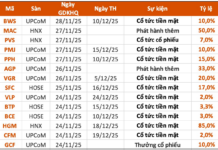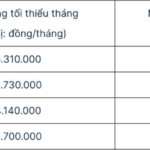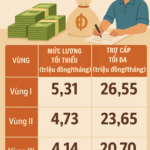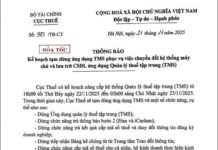Unemployment benefits are calculated at 60% of the average monthly salary used for unemployment insurance contributions over the last six months of employment, but they cannot exceed five times the regional minimum monthly wage as announced by the Government, applicable to the last month of unemployment insurance contributions.
The duration of unemployment benefits is based on the number of months of unemployment insurance contributions. For every 12 to 36 months of contributions, the beneficiary receives 3 months of unemployment benefits. Thereafter, each additional 12 months of contributions adds 1 month of benefits, with a maximum benefit period of 12 months.
According to Decree 293/2025/NĐ-CP (effective from 01/01/2026), the regional minimum monthly and hourly wages for employees are as follows:
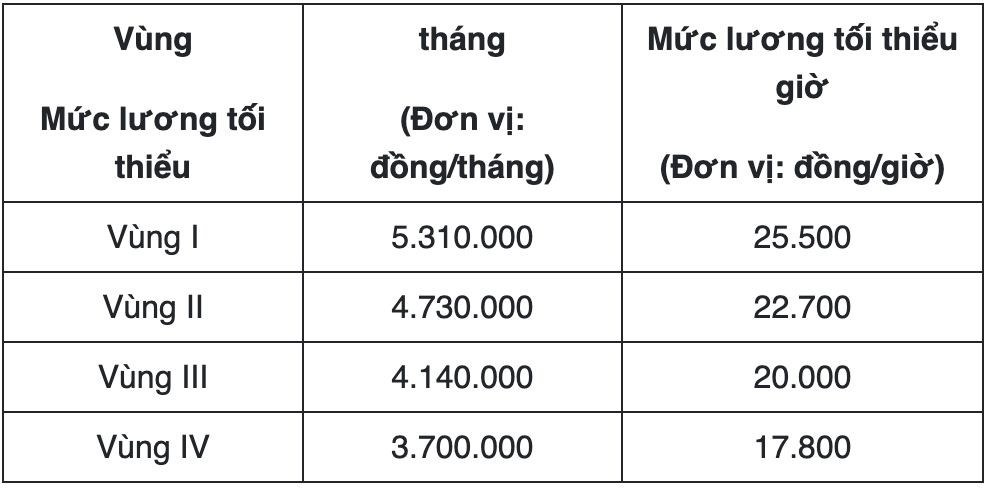
Thus, employees who have contributed to unemployment insurance for 144 months (equivalent to 12 years) are eligible for a maximum of 12 months of unemployment benefits. The maximum unemployment benefit from 1/1/2026 is as follows:

For instance, employees in Region I who have contributed for 144 months can receive up to 318,600,000 VND in unemployment benefits.

The detailed list of Region I areas is specified in Decree 293/2025/NĐ-CP:
Hanoi City
– Region I includes the wards of Hoan Kiem, Cua Nam, Ba Dinh, Ngoc Ha, Giang Vo, Hai Ba Trung, Vinh Tuy, Bach Mai, Dong Da, Kim Lien, Van Mieu – Quoc Tu Giam, Lang, O Cho Dua, Hong Ha, Linh Nam, Hoang Mai, Vinh Hung, Tuong Mai, Dinh Cong, Hoang Liet, Yen So, Thanh Xuan, Khuong Dinh, Phuong Liet, Cau Giay, Nghia Do, Yen Hoa, Tay Ho, Phu Thuong, Tay Tuu, Phu Dien, Xuan Dinh, Dong Ngac, Thuong Cat, Tu Liem, Xuan Phuong, Tay Mo, Dai Mo, Long Bien, Bo De, Viet Hung, Phuc Loi, Ha Dong, Duong Noi, Yen Nghia, Phu Luong, Kien Hung, Thanh Liet, Chuong My, Son Tay, Tung Thien.
The communes of Thanh Tri, Dai Thanh, Nam Phu, Ngoc Hoi, Thuong Phuc, Thuong Tin, Chuong Duong, Hong Van, Phu Xuyen, Thanh Oai, Binh Minh, Tam Hung, Dan Hoa, Phu Nghia, Xuan Mai, Tran Phu, Hoa Phu, Quang Bi, Yen Bai, Doai Phuong, Thach That, Ha Bang, Tay Phuong, Hoa Lac, Yen Xuan, Quoc Oai, Hung Dao, Kieu Phu, Phu Cat, Hoai Duc, Duong Hoa, Son Dong, An Khanh, Gia Lam, Thuan An, Bat Trang, Phu Dong, Thu Lam, Dong Anh, Phuc Thinh, Thien Loc, Vinh Thanh, Me Linh, Yen Lang, Tien Thang, Quang Minh, Soc Son, Da Phuc, Noi Bai, Trung Gia, Kim Anh, O Dien, Lien Minh.
Quang Ninh Province
– Region I includes the wards of An Sinh, Dong Trieu, Binh Khe, Mao Khe, Hoang Que, Yen Tu, Vang Danh, Uong Bi, Dong Mai, Hiep Hoa, Quang Yen, Ha An, Phong Coc, Lien Hoa, Tuan Chau, Viet Hung, Bai Chay, Ha Tu, Ha Lam, Cao Xanh, Hong Gai, Ha Long, Hoanh Bo, Mong Cai 1, Mong Cai 2, Mong Cai 3, and the communes of Quang La, Thong Nhat, Hai Son, Hai Ninh, Vinh Thuc.
Hai Phong City
– Region I includes the wards of Thuy Nguyen, Thien Huong, Hoa Binh, Nam Trieu, Bach Dang, Luu Kiem, Le Ich Moc, Hong Bang, Hong An, Ngo Quyen, Gia Vien, Le Chan, An Bien, Hai An, Dong Hai, Kien An, Phu Lien, Nam Do Son, Do Son, Hung Dao, Duong Kinh, An Duong, An Hai, An Phong, Hai Duong, Le Thanh Nghi, Viet Hoa, Thanh Dong, Nam Dong, Tan Hung, Thach Khoi, Tu Minh, Ai Quoc, Chu Van An, Chi Linh, Tran Hung Dao, Nguyen Trai, Tran Nhan Tong, Le Dai Hanh, Kinh Mon, Nguyen Dai Nang, Tran Luu, Bac An Phu, Pham Su Manh, Nhi Chieu.
The communes of An Hung, An Khanh, An Quang, An Truong, An Lao, Kien Thuy, Kien Minh, Kien Hai, Kien Hung, Nghi Duong, Quyet Thang, Tien Lang, Tan Minh, Tien Minh, Chan Hung, Hung Thang, Vinh Bao, Nguyen Binh Khiem, Vinh An, Vinh Hai, Vinh Hoa, Vinh Thuan, Vinh Thinh, Viet Khe, Nam An Phu, Nam Sach, Thai Tan, Hop Tien, Tran Phu, An Phu, Cam Giang, Cam Giang, Tue Tinh, Mao Dien, Ke Sat, Binh Giang, Duong An, Thuong Hong, Gia Loc, Yet Kieu, Gia Phuc, Truong Tan, Tu Ky, Tan Ky, Dai Son, Chi Minh, Lac Phuong, Nguyen Giap, Nguyen Luong Bang, Phu Thai, Lai Khe, An Thanh, Kim Thanh, and the Cat Hai special zone.
Dong Nai Province
– Region I includes the wards of Bien Hoa, Tran Bien, Tam Hiep, Long Binh, Trang Dai, Ho Nai, Long Hung, Binh Loc, Bao Vinh, Xuan Lap, Long Khanh, Hang Gon, Tan Trieu, Phuoc Tan, Tam Phuoc, and the communes of Dai Phuoc, Nhon Trach, Phuoc An, Phuoc Thai, Long Phuoc, Binh An, Long Thanh, An Phuoc, An Vien, Binh Minh, Trang Bom, Bau Ham, Hung Thinh, Dau Giay, Gia Kiem, Thong Nhat, Xuan Duong, Xuan Dong, Xuan Dinh, Xuan Phu, Xuan Loc, Xuan Hoa, Xuan Thanh, Xuan Bac, Tri An, Tan An, Phu Ly.
Ho Chi Minh City
– Region I includes the wards of Sai Gon, Tan Dinh, Ben Thanh, Cau Ong Lanh, Ban Co, Xuan Hoa, Nhieu Loc, Xom Chieu, Khanh Hoi, Vinh Hoi, Cho Quan, An Dong, Cho Lon, Binh Tay, Binh Phu, Binh Tien, Phu Lam, Tan Thuan, Phu Thuan, Tan My, Tan Hung, Chanh Hung, Phu Dinh, Binh Dong, Dien Hong, Vuon Lai, Hoa Hung, Minh Phuong, Binh Thoi, Hoa Binh, Phu Tho, Dong Hung Thuan, Trung My Tay, Tan Thoi Hiep, Thoi An, An Phu Dong, An Lac, Tan Tao, Binh Tan, Binh Tri Dong, Binh Hung Hoa, Gia Dinh, Binh Thanh.
Binh Loi Trung, Thanh My Tay, Binh Quoi, Hanh Thong, An Nhon, Go Vap, An Hoi Dong, Thong Tay Hoi, An Hoi Tay, Duc Nhuan, Cau Kieu, Phu Nhuan, Tan Son Hoa, Tan Son Nhat, Tan Hoa, Bay Hien, Tan Binh, Tan Son, Tan Thanh, Tan Son Nhi, Phu Tho Hoa, Tan Phu, Phu Thanh, Hiep Binh, Thu Duc, Tam Binh, Linh Xuan, Tang Nhon Phu, Long Binh, Long Phuoc.
Long Truong, Cat Lai, Binh Trung, Phuoc Long, An Khanh, Dong Hoa, Di An, Tan Dong Hiep, An Phu, Binh Hoa, Lai Thieu, Thuan An, Thuan Giao, Thu Dau Mot, Phu Loi, Chanh Hiep, Binh Duong, Hoa Loi, Thoi Hoa, Phu An, Tay Nam, Long Nguyen, Ben Cat, Chanh Phu Hoa, Vinh Tan, Binh Co, Tan Uyen, Tan Hiep, Tan Khanh, Vung Tau, Tam Thang, Rach Dua, Phuoc Thang, Tan Hai, Tan Phuoc, Phu My, Tan Thanh.
The communes of Vinh Loc, Tan Vinh Loc, Binh Loi, Tan Nhut Binh Chanh, Hung Long, Binh Hung, Cu Chi, Tan An Hoi, Thai My, An Nhon Tay, Nhuan Duc, Phu Hoa Dong, Binh My, Dong Thanh, Hoc Mon, Xuan Thoi Son, Ba Diem, Nha Be, Hiep Phuoc, Thuong Tan, Bac Tan Uyen, Phu Giao, Phuoc Hoa, Phuoc Thanh, An Long, Tru Van Tho, Bau Bang, Long Hoa, Thanh An, Dau Tieng, Minh Thanh, Long Son, Chau Pha.
Tay Ninh Province
– Region I includes the wards of Long An, Tan An, Khanh Hau, and the communes of An Ninh, Hiep Hoa, Hau Nghia, Hoa Khanh, Duc Lap, My Hanh, Duc Hoa, Thanh Loi, Binh Duc, Luong Hoa, Ben Luc, My Yen, Phuoc Ly, My Loc, Can Giuoc, Phuoc Vinh Tay, Tan Tap.
What are the eligibility criteria for unemployment benefits from 1/1/2026?
According to Article 38 of the 2025 Labor Law (effective from 01/01/2026), the eligibility criteria for unemployment benefits from 1/1/2026 are as follows:
Employees as defined in Article 31, Clause 1 of the 2025 Labor Law who are contributing to unemployment insurance are eligible for unemployment benefits if they meet the following conditions:
– Termination of the labor contract, work contract, or employment in accordance with the law, except in cases where the employee unlawfully terminates the contract as per the Labor Code or retires with pension eligibility.
– A minimum of 12 months of unemployment insurance contributions within the 24 months preceding the termination of the labor contract, work contract, or employment.
+ For employees with fixed-term contracts of 1 to 12 months, a minimum of 12 months of contributions within the 36 months preceding the termination is required.
– Submission of a complete unemployment benefit application within 3 months from the date of termination.
– Within 10 working days from the submission of the complete application, the employee must not be in any of the following situations: employed and subject to compulsory social insurance as per the Social Insurance Law, performing military or police service, attending school for over 12 months, undergoing mandatory rehabilitation, detained, imprisoned, emigrating, or deceased.
Massive Subsidy Increase Effective January 1, 2026
Starting January 1, 2026, the maximum unemployment benefit for workers will increase due to the implementation of a new calculation method.
Who Qualifies for a Double Increase in Unemployment Benefits Starting 2026?
As of January 1, 2026, both public and private sector employees will share the same maximum unemployment benefit allowance.




















